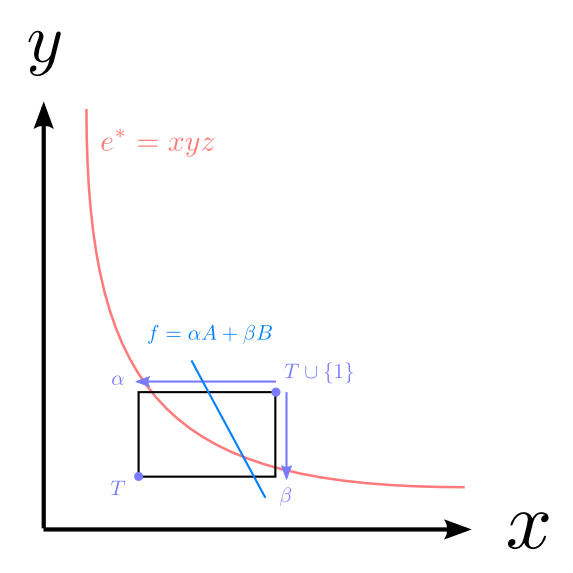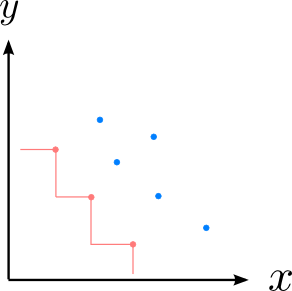J: Exhibition
n, k, A, B, C, x_i, y_i, z_iは入力の定数。
解法
解説上がってたのでそっち読んだほうがいい。
こういう問題は数式で考えるのがいいのか、空間幾何で考えるのがいいのかよくわからない。
2段階に分けると
(1) e*を求める
(2) 画像の添字集合Tを列挙してそれぞれfを求める
(1), (2)に共通して言えるが添字集合S, Tは実際には添字を保つ必要はなく、せいぜいx,y,zのそれぞれの和のtupleがあれば良い。
このtupleを3次元空間の座標と考えてe = xyzのeを最小値を求めるので、このtupleの凸包の頂点で、原点側にある頂点が解の候補となる。
これらはnCkよりずっと少ない。
凸包の頂点を列挙するためにe*を和の式で考えたい。
e*を最小化する添字集合Sを一つ取ってS'とするとS'に依存して何かしらのスカラーP,Q,Rを定数とするとS'は次のe** (e*とは値が異なる) も最小化する。

P,Q,Rは例えば

がある。
P,Q,Rが先に決まっていればP x_i + Q y_i + R z_i = e_iでソートすることでS'が求まる。
これはN個の平行な平面Px + Qy + Rz = e_iを下側から順に並べる感覚。
平面は3点で決まるので試すべき平面はN^3個。
選んだ3点がソートすると連続して並ぶようになる。
この平面を原点まで落として、平面からの距離でソートすれば良い。
頂点が2以下の時や、平面ができない場合のために法線(1,1,1)の平面も試すべき?
よってSの候補とTの候補を求めるのは3点組合せとソートでO(N^4 log N)、
nth_element使えばO(N^4)でできると思う。
(1) S全部調べてe*が求まる。
(2) 各Tについて、(x_1, y_1, z_1)を入れてe*にしつつfを最小化する。
αβγ空間の[0,1]^3の立方体の中で、平面fをずらすと[0,1]^3の辺上で最適な交点を持つ。二次の図で例になるか。

図中の長方形は横x_1、縦y_1であるが、αβ空間では正方形に当たる。
αβγを動かすとfが動き、fはαβγ空間の原点に近いほうが小さい値を取る。
#include<cstdio> #include<iostream> #include<vector> #include<algorithm> #include<string> #include<cstring> #include<map> #include<cmath> #include<set> using namespace std; typedef long long LL; #define y1 MY_y1 #define REP(i, n) for(int i=0; i<int(n); i++) #define EACH(i,c) for(__typeof((c).begin()) i=(c).begin();i!=(c).end();i++) template<class T> inline T &amin(T &a, const T &b) { if (a>b) a=b; return a; } template<class T> inline T &amax(T &a, const T &b) { if (a<b) a=b; return a; } const double INF = 1e12; const double EPS = 1e-9; const int G[2][4] = { {0, 0, 1, 1}, {0, 1, 0, 1}, }; bool LE(double x, double y) { return x <= y + EPS; } int N, K; int A, B, C; int x[55], y[55], z[55]; double E, ans; double X, Y, Z; int x1, y1, z1; vector<int> Xv, Yv, Zv; void update(double X_t, double Y_t, double Z_t) { double a = 1 - (X_t - X) / x1; double b = 1 - (Y_t - Y) / y1; double c = 1 - (Z_t - Z) / z1; if (LE(0, a) && LE(a, 1) && LE(0, b) && LE(b, 1) && LE(0, c) && LE(c, 1)) amin(ans, A*a + B*b + C*c); } // plane OA * s + OB * t // normal vector OC double OA[3], OB[3], OC[3]; // square of distance point_i and plane (OA, OB) double area(int i) { return pow(OC[0] * x[i] + OC[1] * y[i] + OC[2] * z[i], 2); } bool ord(int i, int j) { return area(i) < area(j); } // index set int I[55]; void calc() { REP (t, N) I[t] = t; // choose K-1 products from N-1 products sort(I+1, I+N, ord); int xx = 0, yy = 0, zz = 0; for (int t=1; t<K; t++) { xx += x[I[t]]; yy += y[I[t]]; zz += z[I[t]]; } Xv.push_back(xx); Yv.push_back(yy); Zv.push_back(zz); // choose K product from N products, and minimize E sort(I, I+N, ord); xx = yy = zz = 0; REP (t, K) { xx += x[I[t]]; yy += y[I[t]]; zz += z[I[t]]; } amin(E, (double)xx * yy * zz); } int main() { scanf("%d%d%d%d%d", &N, &K, &A, &B, &C); REP (i, N) scanf("%d%d%d", x+i, y+i, z+i); if (N == 1) { puts("0.000000"); return 0; } x1 = x[0]; y1 = y[0]; z1 = z[0]; E = 1e60; ans = 1e60; OC[0] = OC[1] = OC[2] = 1; calc(); REP (i, N) { REP (j, N) { REP (k, N) { OA[0] = x[j] - x[i] + EPS; OA[1] = y[j] - y[i] + EPS; OA[2] = z[j] - z[i] + EPS; OB[0] = x[k] - x[i] + EPS + EPS; OB[1] = y[k] - y[i] + EPS + EPS; OB[2] = z[k] - z[i] + EPS + EPS; OC[0] = OA[1] * OB[2] - OA[2] * OB[1]; OC[1] = OA[2] * OB[0] - OA[0] * OB[2]; OC[2] = OA[0] * OB[1] - OA[1] * OB[0]; calc(); } } } REP (i, Xv.size()) { X = Xv[i]; Y = Yv[i]; Z = Zv[i]; if (double(X) * Y * Z > E) continue; for (int d=0; d<4; d++) { double X_t, Y_t, Z_t; X_t = X + G[0][d] * x1; Y_t = Y + G[1][d] * y1; if (X_t > EPS && Y_t > EPS) { Z_t = E / X_t / Y_t; update(X_t, Y_t, Z_t); } X_t = X + G[0][d] * x1; Z_t = Z + G[1][d] * z1; if (X_t > EPS && Z_t > EPS) { Y_t = E / X_t / Z_t; update(X_t, Y_t, Z_t); } Y_t = Y + G[0][d] * y1; Z_t = Z + G[1][d] * z1; if (Y_t > EPS && Z_t > EPS) { X_t = E / Y_t / Z_t; update(X_t, Y_t, Z_t); } } } printf("%.9f\n", ans); return 0; }
別解
三次元幾何とかやりたくない。凸包とか知らない。x_iが整数で小さいことを利用してDPで解きたい。
map<pair<int, int>, int> dp[50][51]; dp[i][j][(x,y)] = i番目までのj個使って(x,y)の時のzの最小値;
これはiを消して使いまわしてもAOJでMLEした。
キーを減らさなければならない。xは全て取るとして(y,z)を減らす。
二次平面上の点集合Xについて、Xの部分集合{p | p in X, Xのp以外のどの点qもpの左下にない}をXの前線と呼ぶことにする。
図のピンクの頂点に相当。

2013年アジア地区会津大会で出たやつだ。
set<pair<int,int> > dp[50][51][5001]; dp[i][j][x] = i番目までのj個使ってxの時の(y,z)の前線;
頂点数は凸包より多くなるが、少なくとも凸包の頂点を含んでいる。
この前線を解の候補とするとメモリも間に合い解ける。
ソースコード中ではiを使いまわして節約している。
#include<cstdio> #include<iostream> #include<vector> #include<algorithm> #include<string> #include<cstring> #include<map> #include<cmath> #include<set> using namespace std; typedef long long LL; #define y1 MY_Y1 #define REP(i, n) for(int i=0; i<int(n); i++) #define EACH(i,c) for(__typeof((c).begin()) i=(c).begin();i!=(c).end();i++) template<class T> inline T &amin(T &a, const T &b) { if (a>b) a=b; return a; } template<class T> inline T &amax(T &a, const T &b) { if (a<b) a=b; return a; } const double INF = 1e12; const double EPS = 1e-9; const int G[2][4] = { {0, 0, 1, 1}, {0, 1, 0, 1}, }; bool LE(double x, double y) { return x <= y + EPS; } int N, K; int A, B, C; int x[55], y[55], z[55]; double E, ans; set<pair<int,int> > dp[51][5001], T[5001]; double X, Y, Z; int x1, y1, z1; void insert(set<pair<int, int> > &s, pair<int, int> p) { set<pair<int, int> >::iterator it = s.lower_bound(p); while (it != s.end() && p.second <= it->second) s.erase(it++); if (it != s.begin() && p.second >= (--it)->second) return; s.insert(p); } void update(double X_t, double Y_t, double Z_t) { double a = 1 - (X_t - X) / x1; double b = 1 - (Y_t - Y) / y1; double c = 1 - (Z_t - Z) / z1; if (LE(0, a) && LE(a, 1) && LE(0, b) && LE(b, 1) && LE(0, c) && LE(c, 1)) amin(ans, A*a + B*b + C*c); } int main() { scanf("%d%d%d%d%d", &N, &K, &A, &B, &C); REP (i, N) scanf("%d%d%d", x+i, y+i, z+i); x1 = x[0]; y1 = y[0]; z1 = z[0]; // (x[0], y[0], z[0]) の代わりに (x[N-1], y[N-1], z[N-1])をproduct 1とする swap(x[0], x[N-1]); swap(y[0], y[N-1]); swap(z[0], z[N-1]); dp[0][0].insert(make_pair(0, 0)); REP (i, N) { if (i == N-1) REP (xx, 5001) T[xx] = dp[K-1][xx]; for (int j=i; j>=0; j--) { for (int xx = 5000; xx>=0; xx--) { EACH (e, dp[j][xx]) { pair<int, int> p(e->first + y[i], e->second + z[i]); insert(dp[j+1][xx+x[i]], p); } } } } E = 1e60; for (int xx=0; xx<5001; xx++) { EACH (e, dp[K][xx]) { double yy = e->first, zz = e->second; amin(E, (double)xx * yy * zz); } } ans = 1e60; for (int xx=0; xx<5001; xx++) { EACH (e, T[xx]) { X = xx; Y = e->first; Z = e->second; if (double(X) * Y * Z > E) continue; for (int d=0; d<4; d++) { double X_t, Y_t, Z_t; X_t = X + G[0][d] * x1; Y_t = Y + G[1][d] * y1; if (X_t > EPS && Y_t > EPS) { Z_t = E / X_t / Y_t; update(X_t, Y_t, Z_t); } X_t = X + G[0][d] * x1; Z_t = Z + G[1][d] * z1; if (X_t > EPS && Z_t > EPS) { Y_t = E / X_t / Z_t; update(X_t, Y_t, Z_t); } Y_t = Y + G[0][d] * y1; Z_t = Z + G[1][d] * z1; if (Y_t > EPS && Z_t > EPS) { X_t = E / Y_t / Z_t; update(X_t, Y_t, Z_t); } } } } printf("%.9f\n", ans); return 0; }


